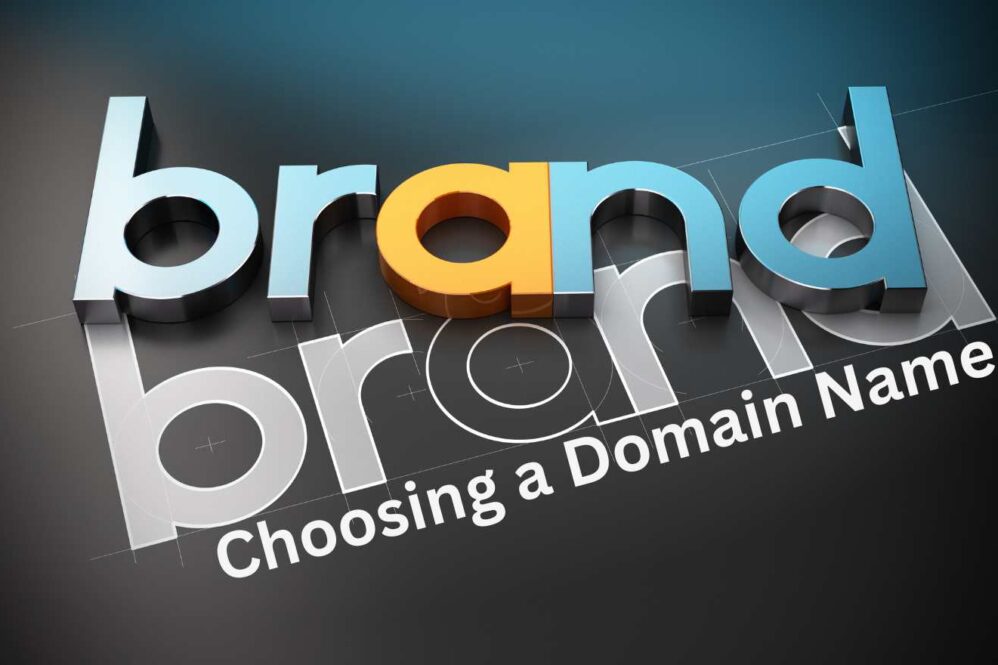While social media platforms play an important role in your online strategy, they should not be your sole focus. Having your own brand website is essential for building a stable, controlled, and professional online presence. Whether you’re a small business owner, a freelancer, or a personal brand, investing in a brand website and securing a relevant domain name will pay dividends in the long run.
Table of Contents
Safeguarding Your Brand with an Owned Brand Website
Having an owned brand website is crucial for safeguarding your brand’s online presence and ensuring control over your messaging. In today’s digital age, where consumers heavily rely on the internet for information and purchasing decisions, it’s essential to have a dedicated online space that you fully own and manage.
Relying solely on third-party platforms, such as social media or online marketplaces, can be risky and leave your brand vulnerable. These platforms operate under their own rules and algorithms, which can change at any time, potentially limiting your reach and visibility. Additionally, you have limited control over the content and presentation of your brand on these platforms, as they dictate the user experience.

By having an owned brand website, you take charge of your brand’s narrative and can present it exactly as you envision. You have complete control over the design, content, and overall user experience, ensuring a consistent and cohesive brand message across all touchpoints. This level of control allows you to build credibility and trust with your audience, as they can easily access accurate and up-to-date information about your products, services, and values.
Moreover, an owned website serves as a central hub for your online presence, making it easier for customers to find and engage with your brand. Unlike third-party platforms, where your content can get lost in the noise, your website acts as a dedicated space solely focused on your brand, increasing visibility and accessibility.
Owning your online presence through a brand website also provides a sense of professionalism and legitimacy. Consumers often perceive businesses with well-designed and informative websites as more credible and trustworthy, which can translate into increased brand loyalty and customer retention.
Defining Your Brand Identity
Establishing a strong brand identity is crucial for safeguarding your brand and ensuring consistency across all channels. Your brand identity encompasses your values, tone, and visual elements that collectively create a unique and recognizable presence for your business.
Begin by clearly defining your brand values. These are the core principles that guide your brand’s actions, decision-making, and overall ethos. Your values should align with your target audience’s beliefs and resonate with them on an emotional level. For example, if sustainability is a key value for your brand, ensure that it is reflected in your products, services, and messaging.
Next, determine the tone of voice that best represents your brand. Your tone should be consistent across all communication channels, from your brand website to social media posts and marketing materials. It should reflect your brand’s personality and resonate with your target audience. A friendly, approachable tone may be suitable for a consumer brand, while a more professional, authoritative tone might be appropriate for a B2B company.
Visual elements, such as your logo, color palette, and typography, play a vital role in creating a cohesive and recognizable brand identity. Your logo should be simple, memorable, and versatile, capable of being used across various mediums. Choose a color palette that aligns with your brand’s personality and values, and ensure that it is consistent across all channels. Similarly, select typography that complements your brand’s visual identity and enhances readability.
Tailoring your content to your target audience is essential for effective brand communication. Conduct thorough research to understand your audience’s preferences, pain points, and communication styles. Craft content that addresses their specific needs and resonates with their values and interests. Consistently delivering relevant and valuable content will help build trust and establish your brand as a credible authority in your industry.
By clearly defining and consistently implementing your brand identity across all channels, you can create a strong, recognizable presence that resonates with your target audience and safeguards your brand’s reputation.
The Importance of Website Design, UX, and Navigation
Having an owned brand website is crucial for safeguarding your brand, and one of the most important aspects to consider is the website’s design, user experience (UX), and navigation. A well-designed brand website with a seamless user experience can significantly enhance your brand’s credibility, trustworthiness, and overall perception.
Effective website design goes beyond just aesthetics; it should prioritize usability, accessibility, and intuitive navigation. A visually appealing website that is difficult to navigate or lacks a clear structure can quickly frustrate users and drive them away. On the other hand, a thoughtfully designed website with a clean layout, clear calls-to-action, and logical information architecture can keep visitors engaged and encourage them to explore your brand further.
User experience (UX) is a critical component of website design. It encompasses the entire journey a user takes while interacting with your website, from initial discovery to completing a desired action. A positive UX can lead to increased user satisfaction, higher conversion rates, and improved brand loyalty. Factors such as page load times, responsiveness, and ease of use all contribute to the overall user experience.

Navigation plays a pivotal role in guiding users through your website and ensuring they can find the information they need quickly and efficiently. A well-structured navigation menu, intuitive breadcrumb trails, and clear labeling can significantly enhance the user experience and reduce frustration. Additionally, incorporating search functionality and sitemaps can further assist users in locating specific content or products.
Optimizing your brand website for different devices and screen sizes is essential in today’s multi-device landscape. Responsive web design ensures that your website adapts seamlessly to various screen sizes, providing an optimal viewing experience across desktops, tablets, and mobile devices. This not only improves usability but also demonstrates your brand’s commitment to meeting the needs of diverse user groups.
Accessibility considerations are another crucial aspect of website design and UX. Ensuring that your website is accessible to users with disabilities, such as those with visual or auditory impairments, is not only ethical but also expands your potential audience. Implementing accessibility features like alt text for images, proper color contrast, and keyboard navigation can make your brand website more inclusive and user-friendly.
By prioritizing website design, user experience, and navigation, you can create a digital presence that accurately represents your brand and provides a positive experience for your visitors. This, in turn, can lead to increased brand recognition, customer loyalty, and ultimately, business growth.
Why Having an Owned Website is Crucial for Safeguarding Your Brand
Having an owned website is essential for safeguarding your brand in today’s digital landscape. It serves as a central hub for your online presence, allowing you to control the narrative and present your brand in the way you want it to be perceived. With an owned brand website, you have the freedom to create valuable, informative content that resonates with your target audience and establishes your brand as a trusted authority in your industry.
One of the key benefits of having an owned website is the ability to implement effective content marketing strategies. By consistently publishing high-quality blog posts, articles, and multimedia content, you can engage your audience, build brand awareness, and establish yourself as a thought leader in your field. This content can also serve as a valuable resource for your customers, providing them with the information they need to make informed decisions about your products or services.
In addition to creating valuable content, an owned brand website allows you to incorporate multimedia elements that enhance the user experience and make your brand more memorable. This can include videos, infographics, podcasts, and interactive elements that help to bring your brand to life and engage your audience on a deeper level.
Furthermore, having an owned website gives you the opportunity to optimize your content for search engines, making it easier for potential customers to find you online. By implementing effective SEO strategies, such as keyword research, on-page optimization, and link building, you can improve your website’s visibility in search engine results pages (SERPs), driving more qualified traffic to your site and increasing your chances of converting visitors into customers.
Encouraging User Interaction and Community Building
Having an owned website allows you to foster a sense of community around your brand. By creating spaces for user interaction, such as forums, comment sections, or social media integration, you can encourage engagement and build a loyal following. This direct connection with your audience provides invaluable insights into their needs, preferences, and pain points, enabling you to tailor your offerings and messaging for maximum impact.
Furthermore, an active community can become a powerful marketing asset, as satisfied customers share their positive experiences and recommendations with others. User-generated content, such as reviews, testimonials, and social media posts, can significantly boost your brand’s credibility and reach, attracting new customers organically.

To fully leverage the community-building potential of your owned brand website, it’s crucial to respond promptly and thoughtfully to feedback, concerns, and inquiries. This responsiveness not only enhances customer satisfaction but also demonstrates your brand’s commitment to open communication and continuous improvement.
Tracking Website Metrics and Analytics
Having an owned website allows you to track and analyze various metrics and data points, providing invaluable insights into your brand’s online performance. By monitoring brand website analytics, you can gain a comprehensive understanding of user behavior, engagement levels, and areas for improvement.
Website metrics such as page views, unique visitors, bounce rates, and time on site can reveal how effectively your content resonates with your target audience. Additionally, you can track conversion rates, lead generation, and e-commerce sales, enabling you to optimize your website’s user experience and sales funnel.
Furthermore, analyzing traffic sources and referral data can help you identify the most effective marketing channels and optimize your digital marketing strategies accordingly. By leveraging data-driven insights, you can make informed decisions to enhance your brand’s online presence and deliver a seamless user experience.
Keeping Up with the Latest Trends and Innovations
Having an owned website is not a one-time effort; it requires continuous monitoring, adaptation, and optimization to stay relevant and effective. The digital landscape is constantly evolving, with new trends, technologies, and best practices emerging regularly. Safeguarding your brand means staying ahead of the curve and proactively embracing these changes.
Regularly review and update your brand website’s design, content, and functionality to align with the latest trends in web design, user experience, and branding. Conduct competitor analysis, monitor industry blogs and publications, and attend relevant conferences or workshops to stay informed about emerging strategies and innovations.
Adapt your website’s visual elements, such as color schemes, typography, and layout, to reflect current design trends and ensure a fresh, modern appearance. Incorporate new technologies, such as responsive design, progressive web apps, or virtual reality experiences, to enhance user engagement and provide a seamless experience across devices.
Continuously optimize your brand website’s content and structure for search engine algorithms, user behavior patterns, and changing consumer preferences. Regularly update your content with fresh, relevant information and leverage data-driven insights to refine your messaging, calls-to-action, and overall content strategy.
Embrace new marketing channels and tactics, such as influencer marketing, social media advertising, or voice search optimization, to reach your target audience effectively. Experiment with innovative branding techniques, such as interactive storytelling or augmented reality experiences, to create memorable and engaging brand experiences.
Regularly review and update your website’s security measures, performance optimization techniques, and accessibility features to ensure compliance with industry standards and best practices. Continuously monitor and address any technical issues, broken links, or compatibility problems to maintain a seamless user experience.
By staying vigilant and proactive in adapting to the latest trends and innovations, you can ensure that your owned brand website remains a powerful asset for safeguarding your brand, engaging your audience, and driving business growth.
Aligning Your Brand Website with Your Brand Strategy
Your website is a powerful marketing asset that should align seamlessly with your overall branding and marketing strategy. By ensuring consistent messaging, visual elements, and tone across all channels, you can reinforce your brand identity and create a cohesive experience for your audience.
Leverage your website to cross-promote your marketing campaigns, content, and initiatives. Integrate calls-to-action, highlight featured content, and showcase your latest offerings. This cross-promotion not only drives traffic to your website but also amplifies the reach and impact of your campaigns.
Embrace a multi-channel approach to maximize your brand’s visibility and engagement. While your brand website serves as the central hub, leverage social media platforms, email marketing, and other digital channels to drive traffic and reinforce your brand message. Consistent cross-promotion across multiple touchpoints enhances brand recognition and fosters a stronger connection with your audience.
Monitoring and Managing Online Reputation
Having an owned website is crucial for safeguarding your brand’s online reputation. It provides a centralized platform where you can monitor and respond to customer reviews, feedback, and sentiment across various channels. By actively engaging with your audience and addressing concerns proactively, you can mitigate potential crises and maintain a positive brand image.
Monitoring online reviews and feedback is essential for understanding customer sentiment and identifying potential issues before they escalate. Set up alerts and regularly check review platforms, social media, and other online communities where your brand is discussed. Promptly respond to negative reviews or feedback, acknowledging the customer’s concerns and offering solutions or explanations.
In case of a crisis or negative sentiment spreading online, having an owned brand website allows you to take control of the narrative. Implement crisis communication strategies by publishing official statements, updates, and clarifications on your website. This ensures that accurate information is readily available to your audience, counteracting misinformation or rumors.

Furthermore, your owned website can serve as a hub for crisis management resources, such as FAQs, contact information for customer support, and guides for addressing specific issues. By providing transparent and easily accessible information, you demonstrate your commitment to addressing customer concerns and rebuilding trust in your brand.
Remember, proactive communication and responsiveness are key to managing your online reputation effectively. Regularly update your brand website with relevant content, address customer feedback, and leverage it as a platform for crisis management to safeguard your brand’s credibility and foster long-term customer loyalty.
The Importance of an Owned Website for Brand Safeguarding
Having an owned website is crucial for safeguarding your brand in today’s digital landscape. As emerging technologies and digital trends continue to shape the way businesses operate, it’s essential to have a platform that you have complete control over. An owned website serves as the foundation for your online presence, allowing you to adapt and scale as needed while ensuring long-term brand building and maintenance.
With an owned brand website, you have the flexibility to stay ahead of the curve and embrace new technologies and trends. Whether it’s incorporating artificial intelligence, augmented reality, or the latest web design trends, your website can evolve alongside these advancements, ensuring that your brand remains relevant and engaging to your target audience.
Moreover, an owned website provides scalability and adaptability, allowing you to expand your online presence as your business grows. You can easily add new features, content, and functionalities without being constrained by external platforms or third-party limitations. This level of control enables you to tailor your brand website to your specific business needs, ensuring a seamless and consistent brand experience across all touchpoints.
Investing in an owned brand website is also a long-term strategy for brand building and maintenance. Unlike rented spaces or social media platforms, where you have limited control over the rules and algorithms, your website is your digital real estate. You can shape your brand’s narrative, establish a strong online identity, and cultivate a loyal customer base. Additionally, an owned website allows you to collect valuable data and insights, enabling you to refine your marketing strategies and enhance your brand’s overall performance.

In the ever-changing digital landscape, an owned brand website serves as a safeguard for your brand, providing you with the control, flexibility, and long-term investment necessary to thrive in an increasingly competitive market.
If you have any more questions or want to get your brand website developed you can connect with our development team at MumbaiFreelancer.com




